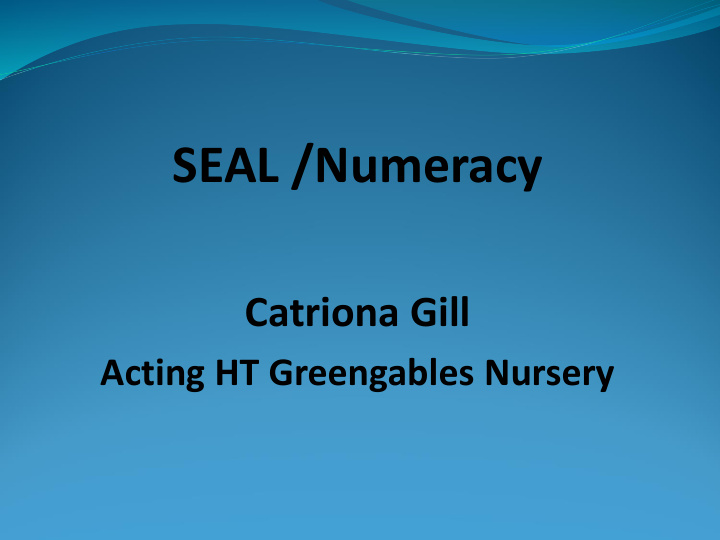



SEAL /Numeracy Catriona Gill Acting HT Greengables Nursery
“We found that most children were developing their counting skills well through a range of learning experiences. . . There is more to be done to ensure staff develop children’s skills and confidence in all areas of numeracy and mathematics” (Quality and Improvement in Scottish Education 2012-2016)
‘The role of the practitioner..[is]..of critical importance if young children are going to extend their thinking, widen their skills and consolidate their learning in play.’ Building the Ambition
Stages of Early Arithmetical Learning SEAL SEAL is based on research about how children learn. You don’t “do” SEAL SEAL is about helping children to develop deep level understanding of number and number operations, using our knowledge of the progression of their learning. Children develop their numeracy skills through real life experiences, routines and PLAY.
Building the Ambition Experiences which… Adults who… An environment which…
What are the features of effective learning and teaching in mathematics? From the early stages onwards, children and young people should experience success in mathematics and develop the confidence to take risks, ask questions and explore alternative solutions without fear of being wrong. They will enjoy exploring and applying mathematical concepts to understand and solve problems, explaining their thinking and presenting their solutions to others in a variety of ways. CfE Mathematics: Principles and Practice
What predicts success in mathematics? Developing: number sense, especially understanding number symbols, eg ‘the fiveness ’ of 5. recognising numbers as dice and domino patterns (subitising) comparing numbers like 5 and 7, saying which is more predicting the result of adding or taking away one developing an understanding of numbers as made up of other numbers (partitioning) developing an understanding of number combinations (Geary, 2011; Gifford, 2014).
Stages of Early Arithmetical Learning
The Teaching and Learning Cycle Where are they now? Where do I want them How will I know when to be? they get there? How will they get there?
The Emergent Child This child: Attempts to count May not understand all counting tasks (social counter) May not know all the number words May not be able to coordinate number words with items May not have the organisational skills
The Emergent Child
Key Messages FNWS /BNWS Starting and stopping at different numbers Number Word Sequences Next number forwards and backwards Number after and before Numeral Identification. Point to the number, can they say it? Numerals Numeral Recognition. Say the number, can they find it? Sequencing numerals forwards and backwards Counting a group/row, forwards and backwards. Creating a collection of a given number. Counting Visible Items Counting two groups/rows. How many altogether? Can they count on?
Key Messages Subitising – seeing how many. Spatial Patterns Dot patterns – dice, pairs and random arrays Support learning with movement and sound Sequential – fingers seen/unseen Simultaneous – fingers seen/unseen Finger Patterns 1-5 Double patterns Keeping track of counting. Copying and counting movements. Temporal Patterns and Sequences Copying and counting rhythmic patterns. Copying and counting sequences and sounds.
A rich context for learning Young children are active social learners. From birth they have an awesome capacity to make sense of the world (their surroundings), to explore, examine and understand it. They learn best in situations which are meaningful and make sense to them. These situations are play , being involved in real experiences and everyday routines
Recommend
More recommend